Comparison of Care Strategies and Quality of Life of Advanced Cancer Patients from Four Different Palliative Care Settings
Keywords:
Levels of palliative care services, Quality of life, Advanced cancerAbstract
บทคัดย่อ
การศึกษาในครั้งนี้มีวัตถุประสงค์เพื่อบรรยายและเปรียบเทียบความแตกต่างของการดูแลแบบประคับประคอง และคุณภาพชีวิตของผู้ป่วยมะเร็งระยะลุกลามที่ได้รับการดูแลในสี่ระดับของการดูแล คือ องค์กรทางศาสนา โรงพยาบาลชุมชน 2 แห่ง โรงพยาบาลมหาวิทยาลัย และศูนย์มะเร็งฮอสพิซ กลุ่มตัวอย่าง เป็นผู้ป่วยมะเร็งระยะลุกลามจำนวน 180 คนที่เข้ารับการรักษาและติดตามผลใน 4 องค์กรข้างต้น และมี คุณสมบัติตามเกณฑ์ที่กำหนด เก็บข้อมูลโดยใช้แบบบันทึกข้อมูลส่วนบุคคล แบบประเมินการดูแลแบบประคับประคอง และแบบวัดคุณภาพชีวิต ผลการศึกษาพบว่าผู้ป่วยมะเร็งระยะลุกลามในโรงพยาบาลชุมชนมีการใช้การดูแลแบบประคับประคอง สูงกว่าผู้ป่วยมะเร็งระยะลุกลามในที่อื่นๆอย่างมีนัยสำคัญทางสถิติ สำหรับการดูแลแบบประคับประคองแบบไม่ใช้ยาผู้ป่วยมะเร็งระยะลุกลามในองค์กรทางศาสนามีการใช้ที่สูงกว่าผู้ป่วยมะเร็งระยะลุกลามในโรงพยาบาลมหาวิทยาลัยและศูนย์มะเร็งฮอสพิซ ในขณะที่ผู้ป่วยมะเร็งระยะลุกลามในโรงพยาบาลชุมชนมีการใช้การดูแลแบบประคับประคองแบบไม่ใช้ยาสูงกว่าผู้ป่วยมะเร็งระยะลุกลามในโรงพยาบาลมหาวิทยาลัยอย่างมีนัยสำคัญทางสถิติ สำหรับการดูแลแบบประคับประคองแบบใช้ยาผู้ป่วยที่ได้รับการดูแลในโรงพยาบาลชุมชนมีการใช้ยาสูงกว่าผู้ป่วยมะเร็งระยะลุกลามในที่อื่นๆ อย่างมีนัยสำคัญ สำหรับคุณภาพชีวิตโดยรวมผู้ป่วยมะเร็งระยะลุกลามในองค์กรทางศาสนาโรงพยาบาลมหาวิทยาลัย และศูนย์มะเร็งฮอสพิซมีคะแนนเฉลี่ยสูงกว่าผู้ป่วยในโรงพยาบาลชุมชนอย่างมีนัยสำคัญทางสถิติ เมื่อพิจารณาในแต่ละด้านของคุณภาพชีวิตพบว่าผู้ป่วยในองค์กรทางศาสนา โรงพยาบาลมหาวิทยาลัยและศูนย์มะเร็งฮอสพิซมีคะแนนเฉลี่ยของด้านความผาสุกและภาวะเหนืออัตตาสูงกว่าผู้ป่วยในโรงพยาบาลชุมชน อย่างมีนัยสำคัญทางสถิติองค์กรต่างๆมีประโยชน์ในแต่ละแง่มุมสำหรับผู้ป่วยมะเร็งระยะลุกลามและครอบครัวซึ่งควรจะได้รับการสนับสนุนจากผู้กำหนดนโยบายด้านสุขภาพ
คำสำคัญ: ระดับของการดูแลแบบประคับประคอง; คุณภาพชีวิต; มะเร็งระยะลุกลาม
Abstract
The purpose of this study was to describe and compare palliative care strategies used forquality of life among Thais with advanced cancer who were receiving care from four different settingsin Thailand, including: a religious organization; two community hospitals; a university hospital;and, a cancer center hospice. One hundred and eighty Thais who were diagnosed with advancedcancer and receiving treatment in one of four selected settings were recruited to complete ademographic questionnaire, a palliative care assessment form, and the Missoula-VITAS Qualityof Life Index.
The results revealed that those who received palliative care in the community hospitalshad a significantly higher mean score in regards to all the palliative care strategies used than thosein the other settings. With respect to the non-pharmacological palliative care strategies, subjectsreceiving care at the religious organization (Buddhist temple) had a significantly higher mean scorethan those receiving care at the university hospital or cancer center hospice, while subjects receivingcare at the community hospitals had significantly higher mean scores than those receiving care at theuniversity hospital. Regarding pharmacological palliative care, subjects receiving care at the communityhospital had significantly higher mean scores than subjects receiving care in all the other settings.In addition, subjects receiving care at the religious organization, university hospital, and cancercenter hospice had significantly higher mean scores, with respect to overall quality of life,than those receiving care at the community hospitals. Also, subjects receiving palliative careat the religious organization, university hospital, and cancer center hospice had significantly higherwell-being and transcendent mean scores than those receiving care at the community hospitals.Furthermore, the various organizations were found to be helpful to the subjects and their families,and should be supported by the healthcare policy makers.
Key Words: Levels of palliative care services; Quality of life; Advanced cancer
Downloads
How to Cite
Issue
Section
License
Copyright: The Pacific Rim International Journal of Nursing Research, Thailand Nursing & Midwifery Council has exclusive rights to publish, reproduce and distribute the manuscript and all contents therein.








.png)



